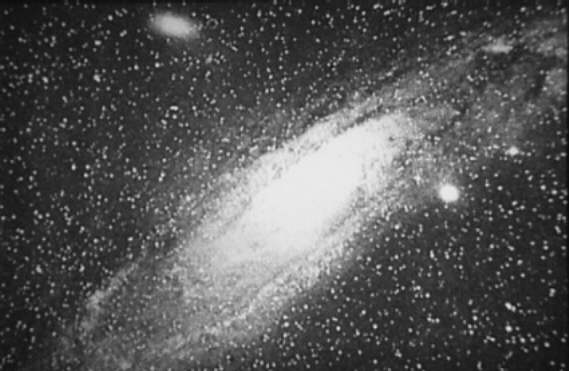Messier 31 (M31), better known as the Andromeda Galaxy, is a large spiral galaxy located in the constellation Andromeda. Lying at a distance of 2.54 million light years from Earth, the Andromeda Galaxy is the nearest major galaxy to our own. It is on a collision course with our home galaxy, the Milky Way. Messier 31 has an apparent magnitude of 3.44. Its designation in the New General Catalogue is NGC 224.
The Andromeda Galaxy was named after the area of the sky that it occupies, the constellation Andromeda, which represents the princess Andromeda in Greek mythology. Andromeda was chained to a rock and left to a sea monster to appease Poseidon after her mother Cassiopeia had boasted that her daughter’s beauty surpassed that of the sea nymphs. The princess was saved by Perseus, the Greek hero represented by the neighbouring constellation.
The Andromeda Galaxy is relatively easy to find in the sky as it is one of the brightest Messier objects. It lies in the vicinity of two prominent asterisms in the northern sky: the Great Square of Pegasus (formed by Alpheratz, Algenib, Markab and Scheat) and Cassiopeia’s W. The only objects listed in Messier’s catalogue that are brighter than M31 are the Pleiades (M45) and the Ptolemy Cluster (M7).
The Andromeda Galaxy is one of the most distant deep sky objects visible to the naked eye. The best time of year to observe it is during the months of October, November and December.
In 10×50 binoculars, the galaxy appears as an oval shaped cloud with a bright nucleus. Binoculars and small telescopes reveal only the galaxy’s bright core, but larger instruments show its full size, which is six times larger than the apparent diameter of the full Moon. The Andromeda Galaxy’s brightest companions, the dwarf galaxies Messier 32 and Messier 110, can also be seen in binoculars.
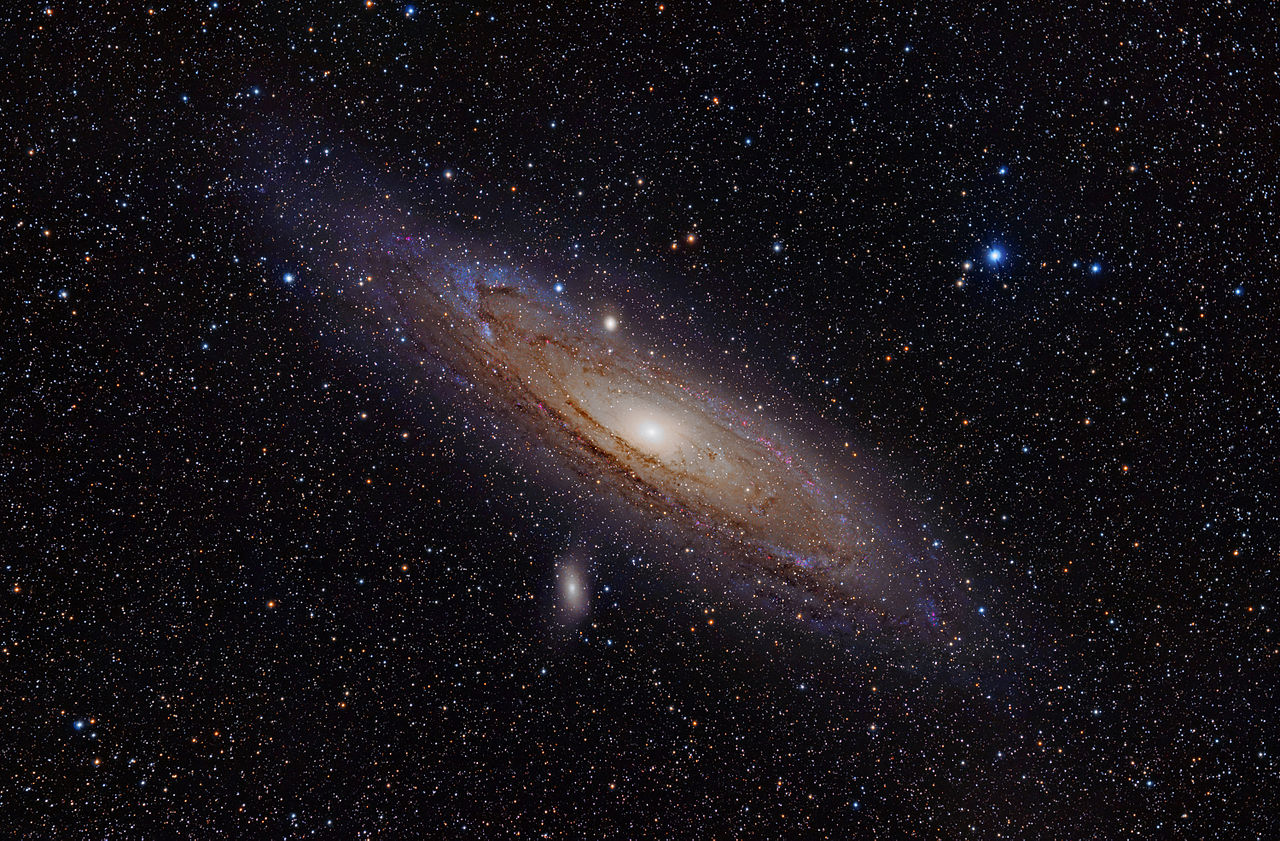
Messier 31 is the largest and most massive member of the Local Group of galaxies, which also includes the Milky Way, the Triangulum Galaxy (M33) and more than 40 smaller galaxies. The Andromeda Galaxy contains a trillion stars, more than twice as many as the Milky Way, which is home to 200 to 400 billion stars.
The two galaxies are roughly equal in mass and will collide in about 3.75 billion years. The collision will likely result in a new giant elliptical galaxy or disk galaxy being formed.
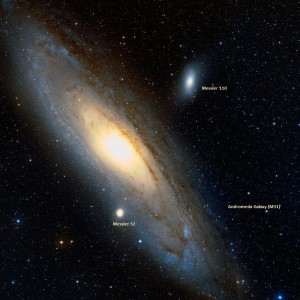
The Andromeda Galaxy has a total of 14 satellite galaxies, of which Messier 32 and Messier 110 are the largest and easiest to observe.
M32 is believed to have undergone a close encounter with M31, which resulted in the smaller galaxy losing its stellar disk and undergoing a dramatic increase in star forming activity in the central region. The starburst activity ended in the relatively recent past.
The Andromeda Galaxy was long believed to be a nebula in our own galaxy, the Milky Way, and was known as the Great Andromeda Nebula. It wasn’t until 1917 that this belief started to be questioned. American astronomer Heber Curtis saw a nova within the galaxy and, after going over the photographic record, found 11 more novae in the region. He noticed that the novae within M31 were about 10 magnitudes fainter than those observed elsewhere in the sky and came up with a new distance estimate for the object: 500,000 light years.
Curtis became a proponent of a new theory which introduced the idea that the objects known as spiral nebulae were in fact independent galaxies. The theory was known as the “island universes” hypothesis. The term “island universes” came from German philosopher Immanuel Kant, who also believed that spiral nebulae were not part of our galaxy.
In 1920, Curtis debated the nature of spiral nebulae and the size of the universe with Harlow Shapley in what is known as the Great Debate or the Shapley-Curtis Debate. The debate took place on April 26 at the Smithsonian Museum of Natural History. Shapley argued that spiral nebulae were part of the Milky Way and that the universe was composed of only one large galaxy, while Curtis contended that spiral nebulae were separate galaxies and that the Milky Way was just one of many galaxies.
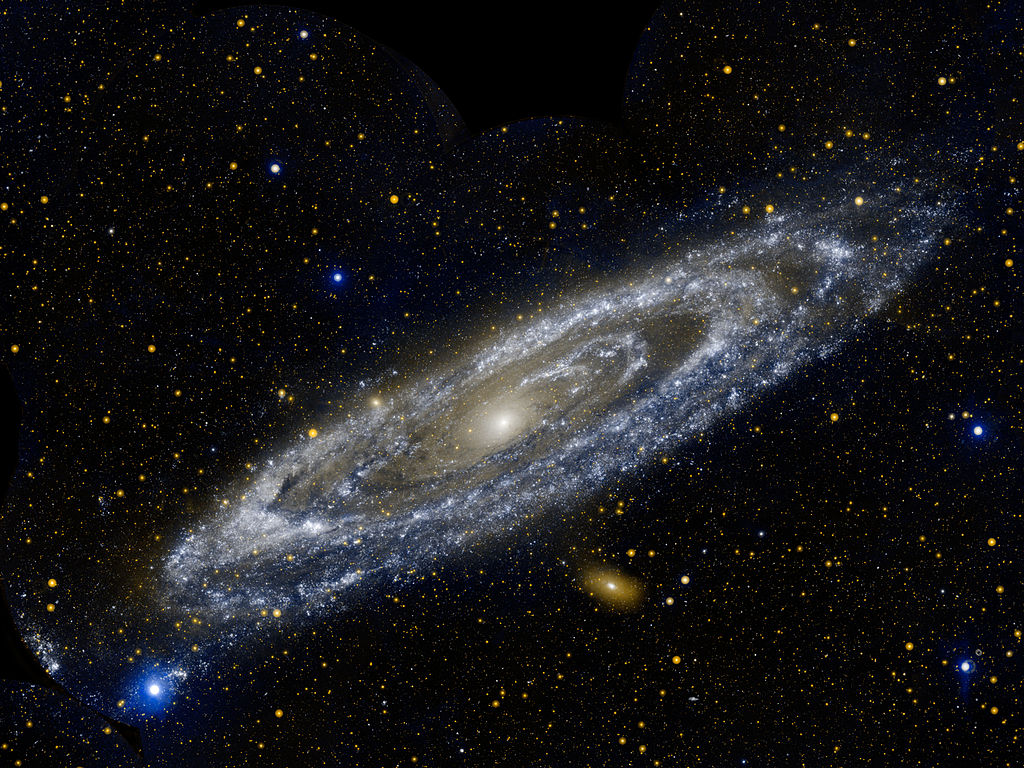
When observed in visible light, Andromeda’s rings look more like spiral arms. The ultraviolet view shows that these arms more closely resemble the ring-like structure previously observed in infrared wavelengths with NASA’s Spitzer Space Telescope. Astronomers using Spitzer interpreted these rings as evidence that the galaxy was involved in a direct collision with its neighbor, M32, more than 200 million years ago. Andromeda is so bright and close to us that it is one of only ten galaxies that can be spotted from Earth with the naked eye. This view is two-color composite, where blue represents far-ultraviolet light, and orange is near-ultraviolet light. Image: NASA/JPL-Caltech
The true nature of M31 was not proven until 1923, when Edwin Hubble established the intergalactic distance between Andromeda and the Milky Way. Hubble identified Cepheid variable stars outside the Milky Way on astronomical images of M31. He did this using the 100-inch Hooker Telescope at Mount Wilson Observatory in Los Angeles, the largest instrument in the world at the time. Hubble’s original estimate placed M31 at an approximate distance of 750,000 light years from Earth.
German astronomer Walter Baade was the first to resolve stars in the Andromeda Galaxy’s central region in 1943. He was also the one to classify stars into two population types: Type I and Type II. He found that each type had a distinct kind of Cepheid variable, which led to distance estimates for M31 doubling and Baade deducing that the universe was about twice as big and old as previously believed.
Baade named the young stars in the Andromeda Galaxy’s disk Type I and the more evolved, red stars in the bulge Type II. The nomenclature was later applied to stars within our own galaxy.
COLLISION
Messier 31 is approaching the Milky Way at about 110 km/s. It is one of the few blueshifted galaxies (moving toward us) from our point of view.
Andromeda is expected to directly collide with our galaxy in about 4 billion years. The collision will most likely result in a merger of the two large galaxies into a giant elliptical galaxy, and possibly even a large disk galaxy. Before the galaxies merge, our solar system may be ejected from the Milky Way and join Andromeda.
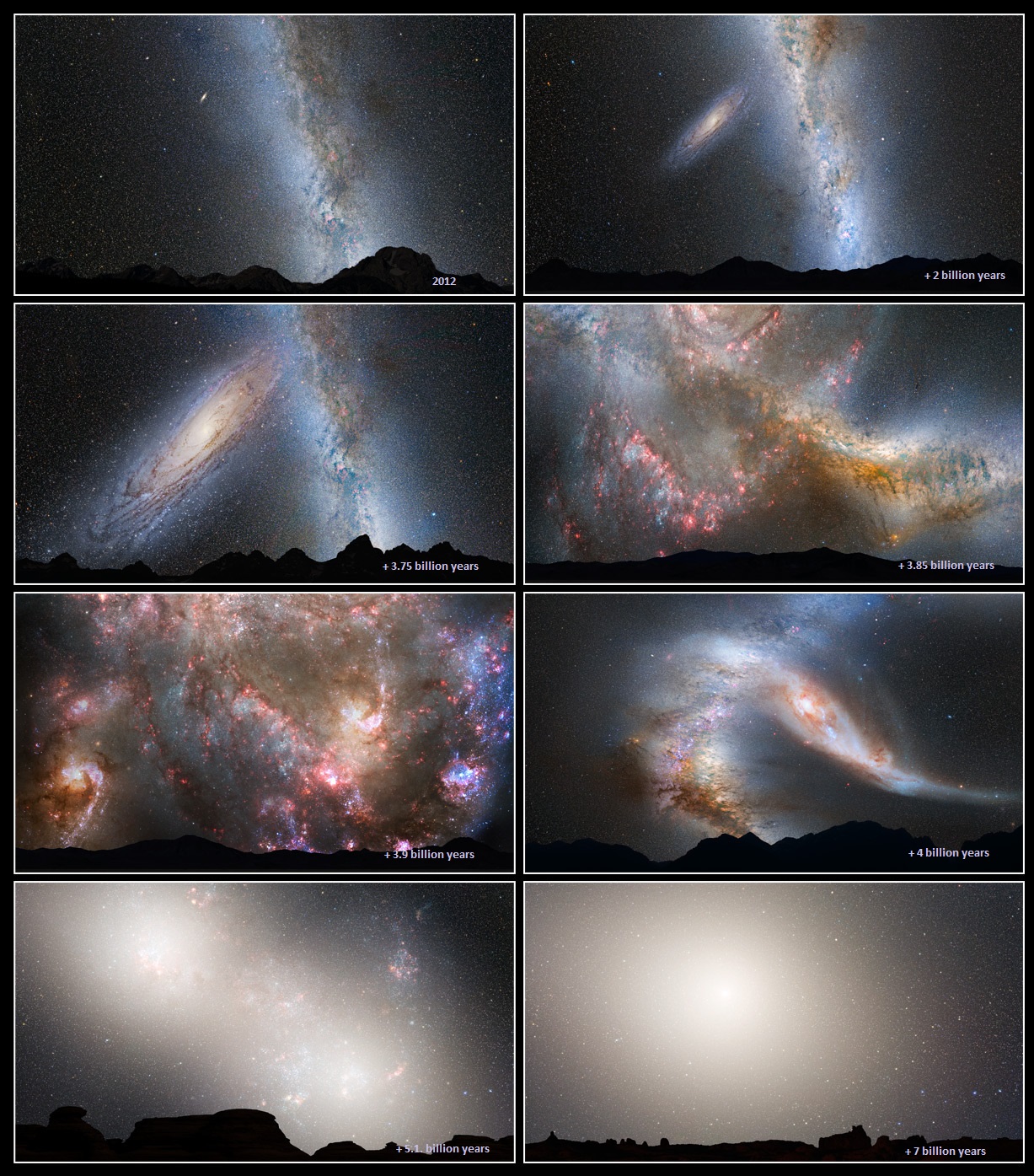
FACTS
The Andromeda Galaxy was formed out of a collision between two smaller galaxies between 5 and 9 billion years ago according to a study released in 2010.
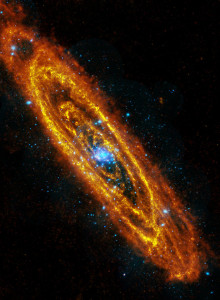
A research published in 2012 estimated an age of roughly 10 billion years for the galaxy, stating that M31 formed from the merger of multiple smaller protogalaxies.
The violent collision that took place about 8 billion years ago resulted in most of the galaxy’s metal-rich halo and extended disk being formed.
Star forming activity was probably intense at that point and resulted in M31 becoming a luminous infrared galaxy (LIRG) for about 100 million years.
These galaxies emit more in the infrared than at all other wavelengths put together. An average luminosity of a LIRG is 100 billion times solar.
Between 2 and 4 billion years ago, Andromeda had a close encounter with the Triangulum Galaxy (M33), which incited high levels of star formation across the galactic disk of M31 and distorted Triangulum‘s outer disk.
The Andromeda Galaxy has a counter-rotating disk of gas in its central region, which is populated by relatively young stars.
This is believed to be the result of a merger with a smaller galaxy that took place about 100 million years ago.
The earliest record of M31 comes from the Persian astronomer Abd al-Rahman al-Sufi, who mentioned the chained constellation, referring to Andromeda, or the Chained Maiden, in his Book of Fixed Stars in 964. Al-Sufi described the Andromeda Galaxy as a “small cloud.”
The first documented telescopic observation of the galaxy was provided by the German astronomer Simon Marius on December 15, 1612. Marius wrote:
Of these observation the first is, that since December 15, 1612, I have discovered & observed a star or a fixed star, as I could not find elsewhere in all the sky. It is situated near the third & northern star in the girdle of Andromeda. Without instrument there can be seen something like a nebula; but with the telescope no stars can be seen, as in the nebula in Cancer [Beehive Cluster, M44] & other nebulous stars, but only glimmering rays, which are the brighter the closer they are to the center. In the center is a faint & pale glow which occupies a diameter of about a quarter of a degree. A similar glow occurs, if the flame of a candle is seen through transparent horn. The nebula appears not dissimilar to the comet, which Tycho Brahe has observed in the year 1586.
In September of last year, the highly erudite gentleman M. Lucas Brunnius, mathematician at His Highness the Elector of Saxony was staying with me. Between our mathematical colloquia, with the sky offering great serenity, I also showed him this strange star; he observed it with the greatest admiration. If, however, this stars is a new one, I cannot say with certainty; others may determine & judge this. I’m surprised about the most sharpviewed Tycho, who has determined for a fixed star lying little more north in the girdle of Andromeda, with his instruments, longitude & latitude, but left untouched this nebula, despite it is very close to it.
Charles Messier credited Marius for the discovery of M31, unaware of the Persian astronomer’s earlier observations. This is what Messier wrote in the first edition of his catalogue (1771):
The sky has been very good in the night of August 3 to 4, 1764; & the constellation Andromeda was near the Meridian, I have examined with attention the beautiful nebula in the girdle of Andromeda, which was discovered in 1612 by Simon Marius, & which has been observed since with great care by different astronomers, & at last by M. le Gentil who has given a very ample & detailed description in the volume of the Memoirs of the Academy for 1759, page 453, with a drawing of its appearance. I will not report here what I have written in my Journal: I have employed different instruments for examining that nebula, & above all an excellent Gregorian telescope of 30 pouces focal length, the large mirror having 6 pouces in diameter, & magnifying 104 times these objects: the middle of that nebula appeared rather bright with this instrument, without any appearance of stars; the light went diminishing up to extinguishing; it resembles two cones or pyramides of light, opposed at their bases, of which the axis was in the direction form North-West to South-East; the two points of light or the two summits are about 40 minutes of arc apart; I say about, because of the difficulty to recognize these two extremities. The common base of the two pyramides is 15 minutes [of arc long]: these measures have been made with a Newtonian telescope of 4 feet & a half focal length, equipped with a micrometer of silk wires. With the same instrument I have compared the middle of the summits of the two cones of light with the star Gamma Andromedae of fourth magnitude which is very near to it, & little distant from its parallel. From these observations, I have concluded the right ascension of the middle of this nebula as 7d 26′ 32″, & its declination as 39d 9′ 32″ north. Since fifteen years during which I viewed & observed this nebula, I have not noticed any change in its appearances; having always perceived it in the same shape.
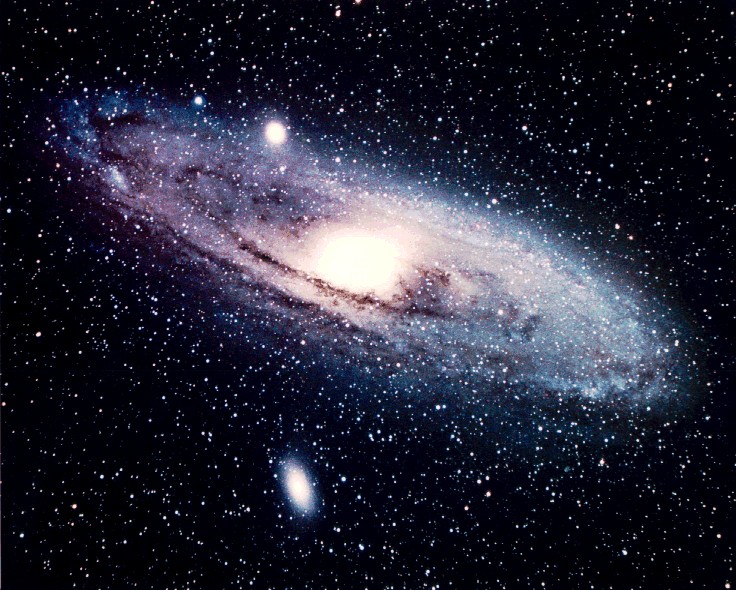
William Herschel, who first observed the object on August 6, 1780, believed the Great Andromeda Nebula to be the nearest of all the “great nebulae” in the night sky. He incorrectly estimated the distance to M31 to be no more than 2,000 times than that to Sirius, which lies 8.611 light years from Earth:
The ninth [very compound Nebula, or Milky-Way] is that in the girdle of Andromeda, which is undoubtedly the nearest of all the great nebulae; its extent is above a degree and a half in length and, in even one of the narrowest places, not less than 16′ in breadth. The brightest part of it approaches to the resolvable nebulosity, and begins to shew a faint red colour; which, from many observations on the colour of and magnitude of nebulae, I believe to be an indication that its distance in this coloured part does not exceed 2000 times the distance of Sirius. There is a very considerable, broad, pretty faint, small nebula [Messier 110] near it; my Sister [Caroline] discovered it August 27, 1783, with a Newtonian 2-feet sweeper. It shews the same faint colour with the great one, and is, no doubt, in the neighbourhood of it. It is not the 32d of the Connoissance des Temps [Messier 32]; which is a pretty large round nebula, much condensed in the middle, and south following the great one; but this is about two-thirds of a degree north preceding it, in a line parallel to Beta and Nu Andromedae.

Admiral William Henry Smyth observed M31 in September 1833 and noted the following:
sf [south following, SE] edge of the general mass, and of a milky irresolvable nebulosity; but though described “in cingulo Andromedae,” it is between the robes and the left arm of the Lady, and certainly below its girdle. There are numerous telescopic stars around; and three minute ones are involved in the glow, but which can have no connection with it, and are doubtless between our system and the nebulosity. The axis of direction trends sp and nf [south preceding and north following, SW to NE]; and it may be caught by a good eye, on a very fine night, by running a fancied line from Alamak to Mirak, and from thence carrying a rectangular glance to a distance of about 6 1/2 deg. It can also be struck upon by a ray from Gamma in the mouth of Cetus, over Sheratan in the head of Aries, through Mirak, or Beta Andromedae, to 6 1/2 deg beyond.
This is the oldest known nebula; for though it attracted but little notice till the seventeenth century, it was seen, at least, as far back as 905 A.D. Simon Marius re-discovered it, — if such a term can be applied to an object seen with the naked eye: in his rare work — De Mundo Jovialis – that astronomer acquaints us, that he first examined it with a telescope on the 15th Dec. 1612; he was astonished at the singularity of the phenomenon, but expressly says, that he leaves it to others to judge whether it was a new discovery or not. It was therefore by an oversight, that Halley ascribes the discovery, in 1661, to Bullialdus (Ismaël Boulliaud); who himself mentions its being known as Nebulosa in cingulo Andromedae, and that it had been noticed 150 years before, by an expert though anonymous astronomer. The tenuity of its boundary offering no definition for exact comparison, has made the several attempts to figure it so conflicting as to mislead. Marius describes it as resembling the diluted light of the flame of a candle seen through horn, — Halley mentions that it emits a radiant beam, — Cassini calls it à peu-près triangulaire, — Le Gentil considered it round for some years, then oval, but always of an uniform light in all its parts, — while Messier represents it as resembling two cones, or pyramids of light, opposed by their bases. From such statements, Boulliaud and Kircher thought this wonderful object appeared and disappeared, like Mira; and Le Gentil had no doubt of its undergoing changes in form. But probably this discordance is a consequence of the means employed. Le Gentil, by his paper of 1749, seems to have used telescopes of various sizes, in order to see it very clearly — “non seulement pour servir à la reconnoître, mais encore pour voir si dans la suite elle ne seroit point sujette à variation, soit dans la figure, soit dans la position;” yet fifteen years afterwards Messier differs from him, by assigning a greater brilliance to the centre than to the edges, which latter accords better with my views of it, than do our apparent mean places. It is, however, remarkable that Messier examined this giant nebula with a 4 1/2 foot Newtonian, and then turned the instrument upon Gamma Andromedae — “qui en étoit fort près” — to compare its light with that of the star, on a beautiful night of August, 1764; but he makes no mention of the duplicity, or contrasted colours, of that lovely star.
The companion [Messier 32] was discovered in November, 1749, by Le Gentil, and was described by him as being about an eighth of the size of the principal one; he adds, “elle m’a paru exactement de la même densité que l’ancienne.” The light is certainly more feeble than here assigned. Messier – whose No. 32 it is – observed it closely in 1764, and remarked, that no change had taken place since the time of its being first recorded. In form it is nearly circular. The powerful telescope of Lord Rosse has been applied to this, after finding that no actual re-solution in the large nebulae could be seen, though its edge had stellar symptoms; and it proved to be clearly resolvable into stars – the which directly interferes with Le Gentil’s remark.
In 1864, English astronomer William Huggins noticed that the spectrum of M31 was different from that of a gaseous nebula, which led to the conclusion that the object was stellar in nature.
In 1885, a supernova event was observed in M31. Now known as S Andromedae or SN 1885A, this was the only supernova ever detected in the galaxy. At the time, M31 was believed to be closer to us than it really is and astronomers thought they were seeing a nova event, so they named it Nova 1885. Novae, which are significantly less luminous than supernovae, are cataclysmic nuclear explosions that occur on the surface of a white dwarf in a binary system.
In 1887, Welsh engineer and amateur astronomer Isaac Roberts took the first photographs of the Andromeda Galaxy from Sussex, England. His long-exposure images revealed the galaxy’s spiral structure for the first time, but did not alter the belief that M31 was a nebula within the Milky Way.
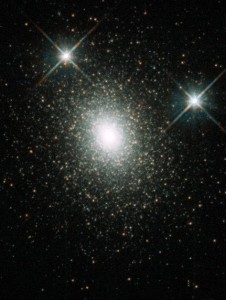
The Andromeda Galaxy is home to the most luminous globular cluster in the Local Group. The cluster Globular One (G1) contains several million stars and has an apparent magnitude of 13.72, which makes it brighter than the Milky Way’s brightest globular, Omega Centauri.
Also catalogued as Mayall II, G1 is even visible in 10-inch or larger telescopes in good conditions. Because of its mass and stellar population, G1 is considered by some to be a remnant core of a dwarf galaxy.
The Andromeda Galaxy contains an estimated 450 globular clusters in total. The cluster G76, located in the southwest arm, has the greatest apparent brightness. Another massive globular cluster was discovered in 2006 that has similar properties to Mayall II. It was catalogued as 037-B327.
Messier 31 also contains a bright star cloud designated NGC 206. The object was catalogued by William Herschel as H V.36 after observing it on October 17, 1786.
The Andromeda Galaxy has a double nucleus, which was revealed by the Hubble Space Telescope in 1991. The second nucleus may have belonged to a smaller galaxy that was devoured by M31, or it may be an illusion caused by dust clouds obscuring parts of the galaxy’s central region.
The first extragalactic microquasar was discovered in M31 in 2012. The radio burst was detected emanating from a progenitor black hole near the galaxy’s core. The black hole had an estimated mass of 10 solar masses.
The Andromeda Galaxy has often been featured in works of fiction. Some authors kept referring to it as the Andromeda Nebula in their works long after the 1920s. They include science fiction author Jack Vance, who always called it a nebula in his novels, and Ivan Yefremov, the author of Andromeda Nebula (1957).
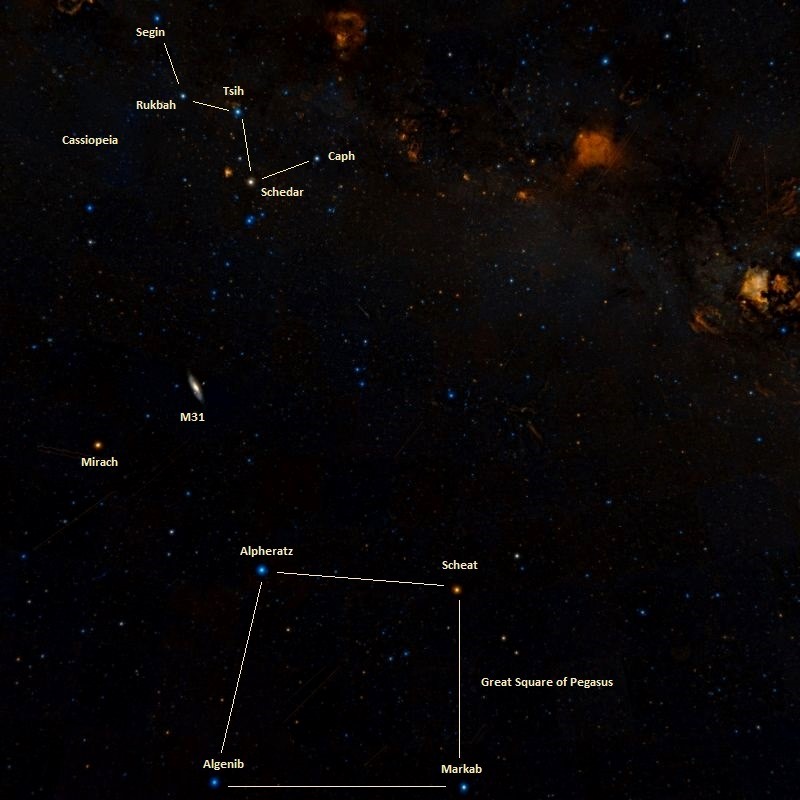
LOCATION
The Andromeda Galaxy is pretty easy to find as it lies between two prominent asterisms, the W of Cassiopeia and the Great Square of Pegasus. The bright stars in the constellation Andromeda form a chain that starts with Alpheratz, the northernmost star in the Great Square, and leads first to Delta Andromedae, then to Mirach, and finally to Almach, the star nearest to Cassiopeia.
Messier 31 can be found 8 degrees to the northwest of the middle star, Mirach. The galaxy is visible to the naked eye and appears as a hazy patch of light even in less than ideal observing conditions.
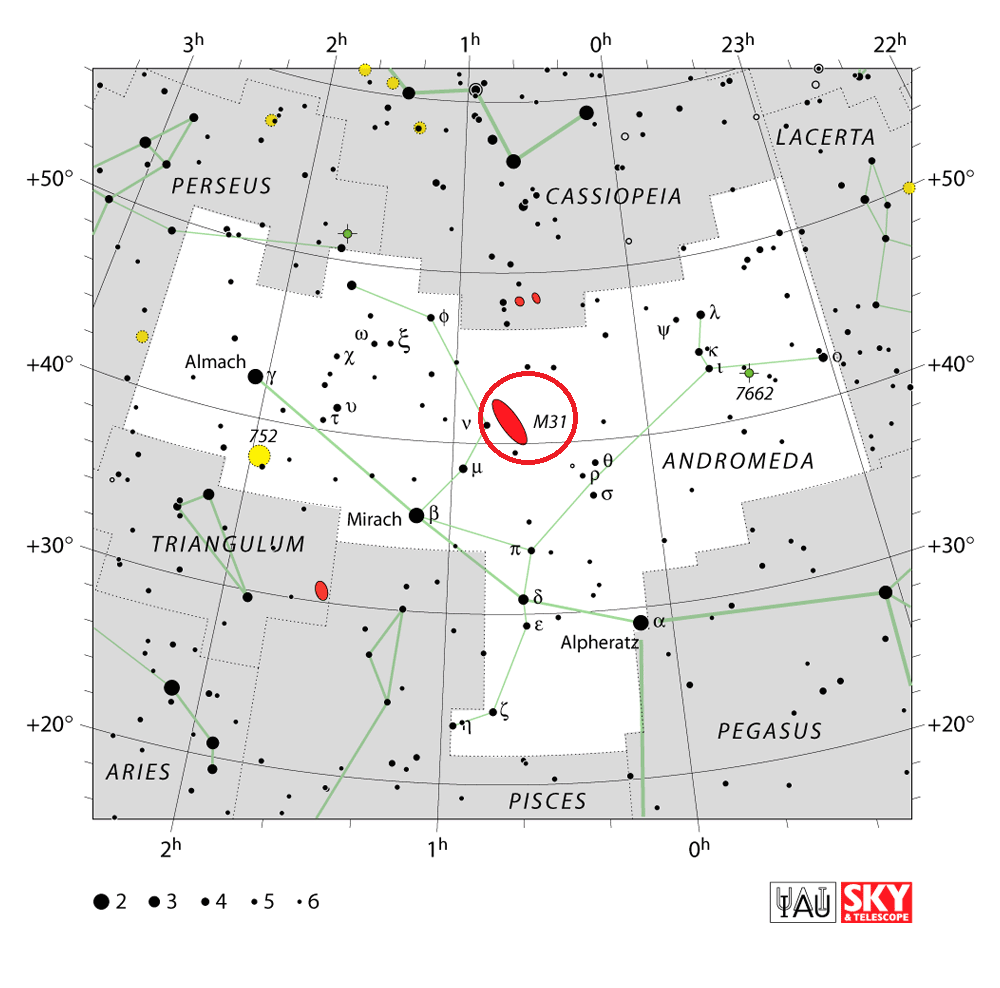
PLANETS
The first planet candidate in M31 may have been discovered in 2009 using gravitational microlensing, a phenomenon that allows astronomers to see smaller objects located in the background of very massive objects. The massive objects in the foreground deflect the light of the smaller object, resulting in several images of the smaller background object appearing distorted and enlarged near the larger object.
The extragalactic planet has a mass only 6 to 7 times that of Jupiter. It was first detected in 2004, but believed to be a star in a binary system. In 2009, scientists revisited the microlensing event and concluded that it was more likely to be a star with a smaller companion.
SIZE & TYPE
Messier 31 is classified as an SA(s)b galaxy based on visible light images, but data from the Two Micron All-Sky Survey (2MASS), a survey of the entire sky in three infrared wavebands between 1997 and 2001, revealed that the galaxy’s bulge is box-like in shape, indicating that Andromeda is a barred spiral galaxy, just like the Milky Way, and that its bar is seen along its long axis when viewed from Earth.
In 2005, M31 was discovered to have a large extended stellar disk, spanning more than 220,000 light years in diameter. The galaxy was previously thought to have a diameter between 70,000 and 120,000 light years.
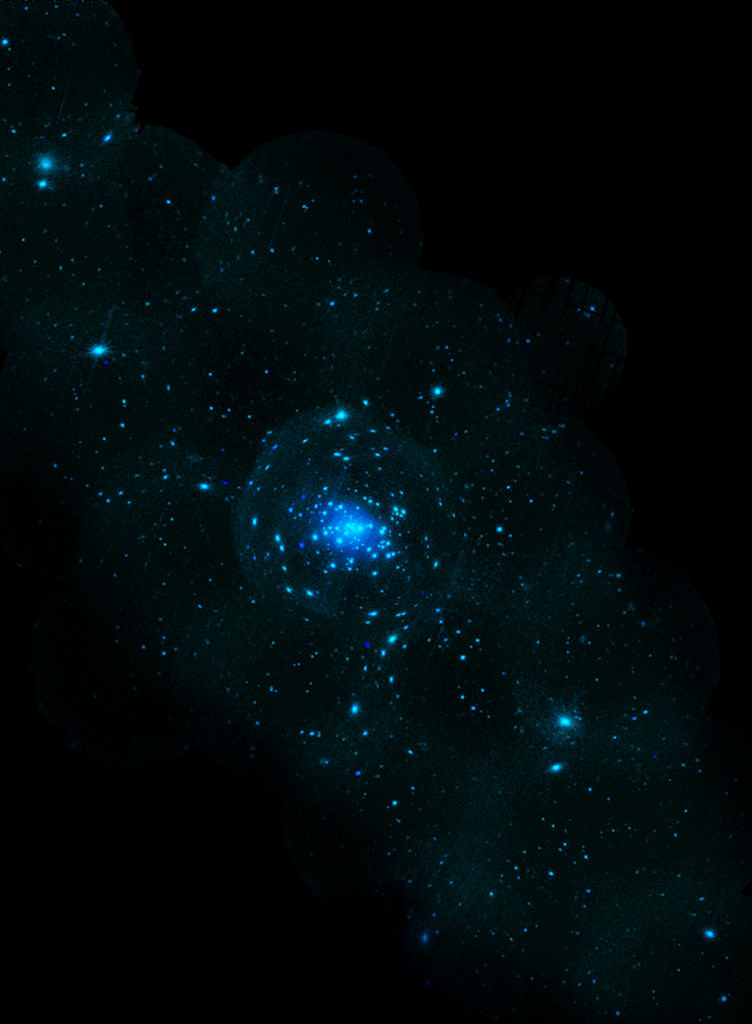
XMM-Newton is capturing what happens at the end of the lives of massive stars. It shows the high-energy X-rays that come from, among other objects, supernova explosions and massive dead stars rotating around companions. These X-ray sources are clustered in the center of the galaxy, where the most massive stars tend to form. Image: ESA/XMM-Newton/EPIC/W. Pietsch
Messier 31 is inclined at about 77 degrees relative to Earth. As a result of gravitational interaction with the nearby galaxies, it has a notable S-shaped warp rather than a flat disk.
Walter Baade was the first to study the Andromeda Galaxy’s spiral arms in great detail. He concluded that it had two tightly wound spiral arms that were more widely spaced that the Milky Way’s arms.
Studies of M31 have revealed a normal spiral galaxy with spiral arms wound up clockwise. The spiral arms are separated from each other by at least 13,000 light years. The spiral pattern is somewhat distorted by the galaxy’s interactions with M32 and M110.
Images taken by the European Space Agency’s Infrared Space Observatory (ISO) in 1998 showed that M31 may be transitioning into a ring galaxy. The dust and gas within the galaxy form several overlapping rings and one of these stands out in particular. The ring is formed at a radius of 32,000 light years from the galaxy’s core and can be seen in visible light images. The Spitzer Space Telescope (SST), NASA’s infrared space observatory, revealed two spiral arms emerging from a central bar. The arms have a segmented structure and continue beyond the galaxy’s ring mentioned above.
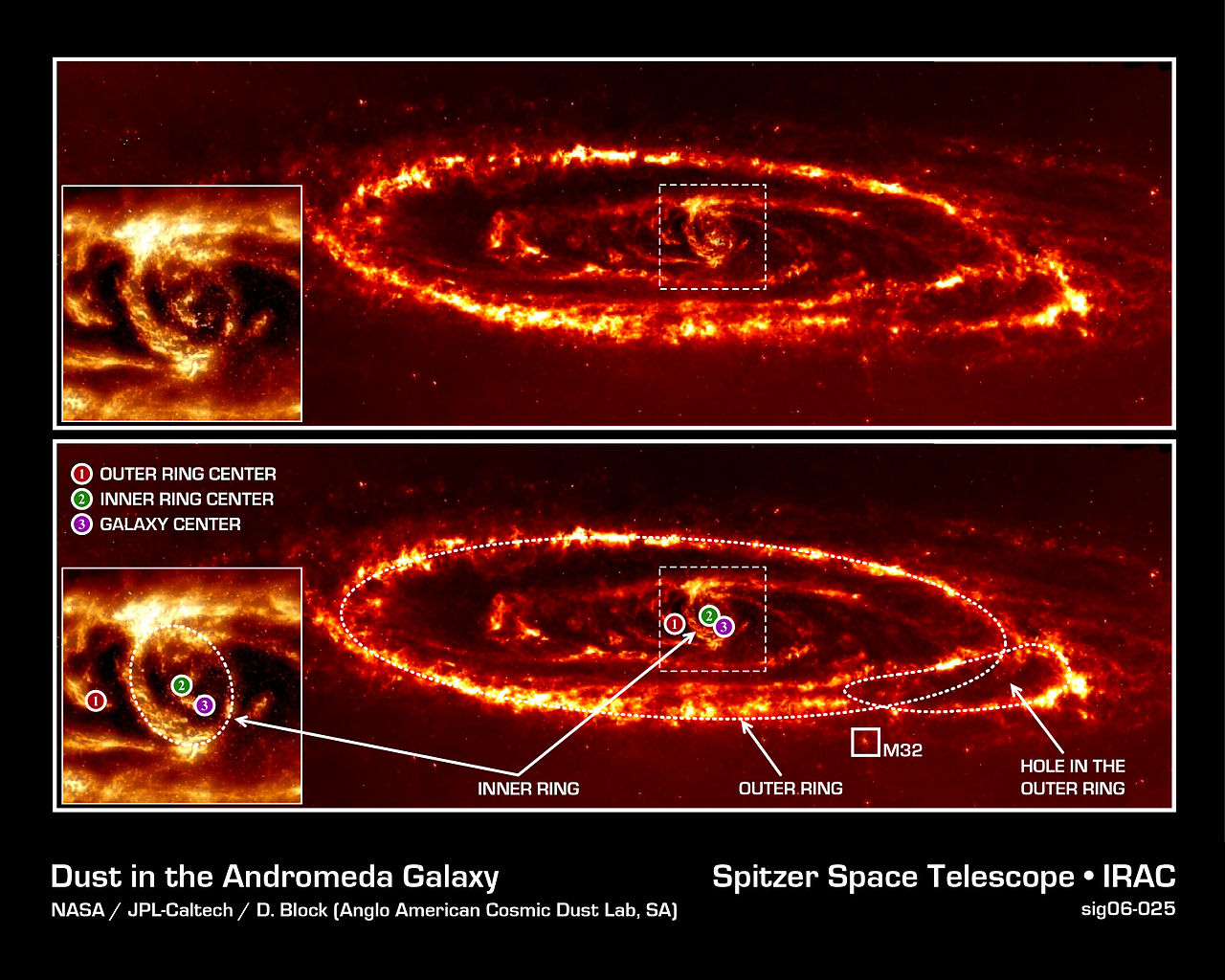
The ring structures are believed to have been created as a result of interaction with M32 over 200 million years ago. M32 likely passed through the disk of M31, which left M32 stripped of more than half its mass.
The stars in the extended halo of M31 are metal-poor, like those in our galaxy. The Milky Way and Andromeda likely had similar evolutionary paths, with each galaxy swallowing and assimilating 100 to 200 smaller galaxies over the past 12 billion years.
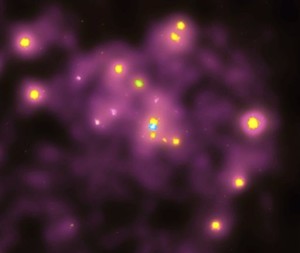
The Andromeda Galaxy’s nucleus is home to a dense, compact star cluster.
The inner nucleus consists of two concentrations, designated P1 and P2 and separated by 4.9 light years.
P2 is dimmer and falls at the galaxy’s true centre, while the brighter P1 is offset from the centre.
P2 contains a black hole with a mass of about 140 million suns.
The blue stars found orbiting the black hole are only 200 million years old and likely formed in the vicinity of the central black hole in a sudden burst of star formation.
The compact star cluster is surrounded by the galaxy’s larger double nucleus, which is in fact an elliptical ring of evolved red stars that orbit the black hole at a greater distance than the blue stars.
When they reach the farthest point in the orbit, the stars move slower, giving the illusion of a second nucleus.
A total of 35 stellar-mass black holes have been detected in the Andromeda Galaxy, out of which seven are within 1,000 light years of the galaxy’s centre.
These black holes formed by gravitational collapses of massive stars and have a mass about 5 to 10 times that of the Sun.
INFORMATION
| Object: Galaxy |
| Type: Spiral |
| Class: SA(s)b |
| Designations: Messier 31, M31, Andromeda Galaxy, NGC 224, LEDA 2557, Bode 3, Flamsteed 58, PGC 2557, UGC 454, Hevelius 32, GC 116, CGCG 535-17, MCG +07-02-016, IRAS 00400+4059, 2MASX J00424433+4116074, h 50, Ha 3.3, IRC +40013, GIN 801, DA 21, K79 1C, RAFLG 104, 2C 56 (core) |
| Constellation: Andromeda |
| Right ascension: 00h 42m 44.3s |
| Declination: +41°16’9” |
| Distance: 2.54 million light years (778,000 parsecs) |
| Number of stars: 1 trillion |
| Apparent magnitude: +3.44 |
| Absolute magnitude: -21.5 |
| Apparent dimensions: 190′ x 60′ |
| Size: 220,000 light years (linear diameter) |
| Redshift: -0.001001 |
| Helio radial velocity: -301 km/s |
IMAGES
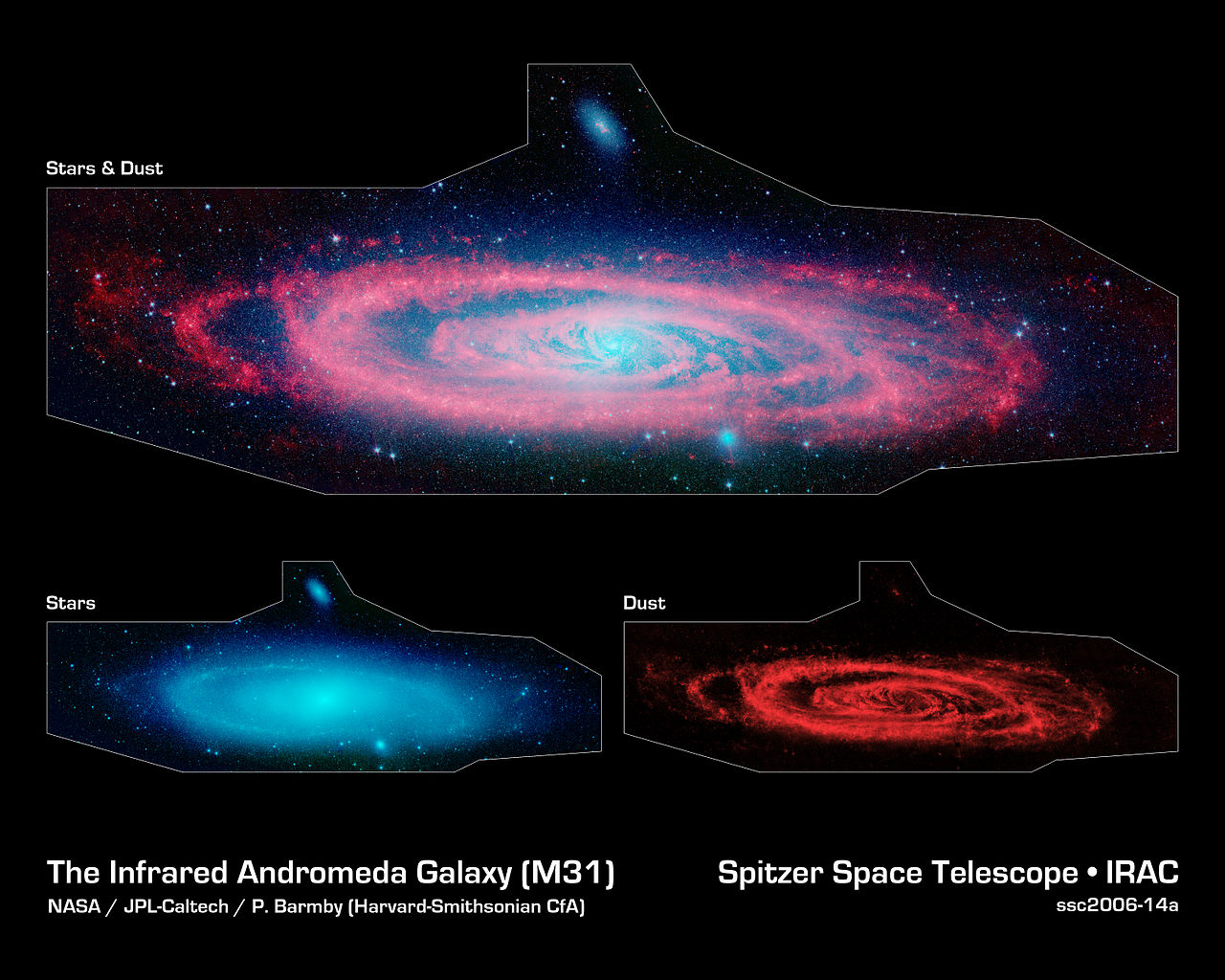
Astronomers used these new images to measure the total infrared brightness of Andromeda. Because the amount of infrared light given off by stars depends on their masses, the brightness measurements provided a novel method for “weighing” the Andromeda galaxy. According to this method, the mass of the stars in Andromeda is about 110 billion times that of the sun, which is in agreement with past calculations. This means the galaxy contains about one trillion stars (because most stars are actually less massive than the sun). For comparison, the Milky Way is estimated to hold about 400 billion stars. A small, companion galaxy called NGC 205 is visible above Andromeda. Another companion galaxy called M32 can also been seen below the galaxy. Image: NASA/JPL-Caltech/P. Barmby (Harvard-Smithsonian CfA)

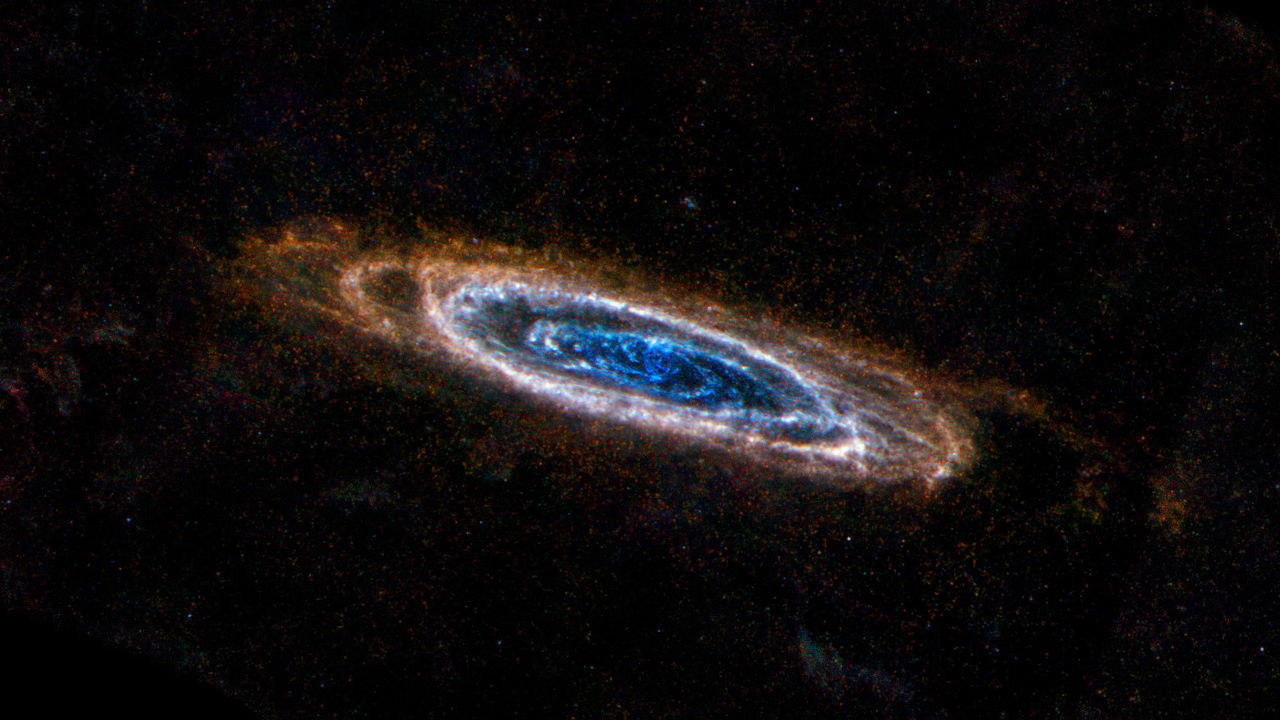
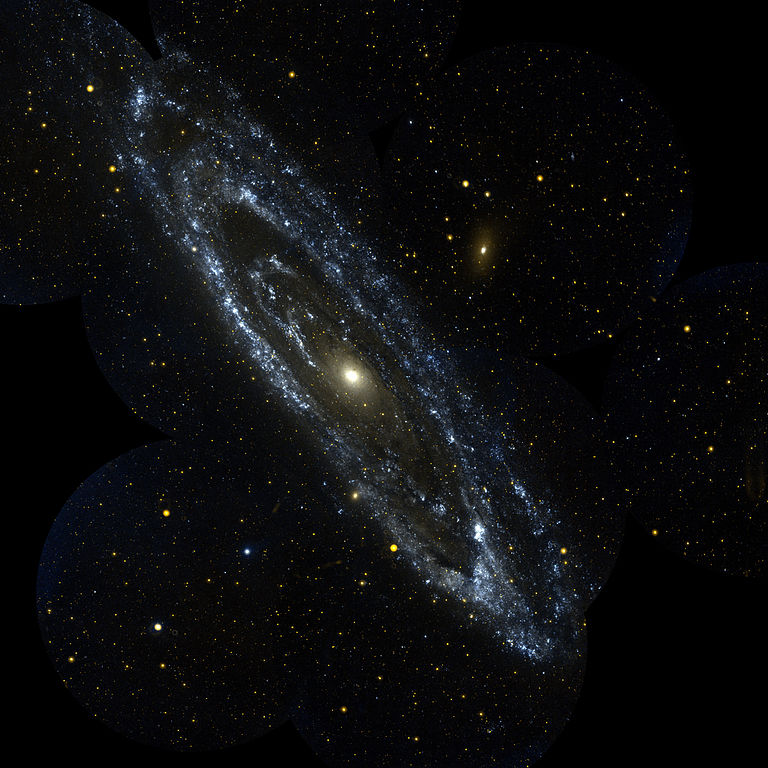
The wisps of blue making up the galaxy’s spiral arms are neighborhoods that harbor hot, young, massive stars. Meanwhile, the central orange-white ball reveals a congregation of cooler, old stars that formed long ago. Andromeda is so bright and close by that it is one of only three galaxies that can be spotted from Earth with the naked eye. This view is two-color composite, where blue represents far-ultraviolet light, and red is near-ultraviolet light. Image: NASA/JPL-Caltech
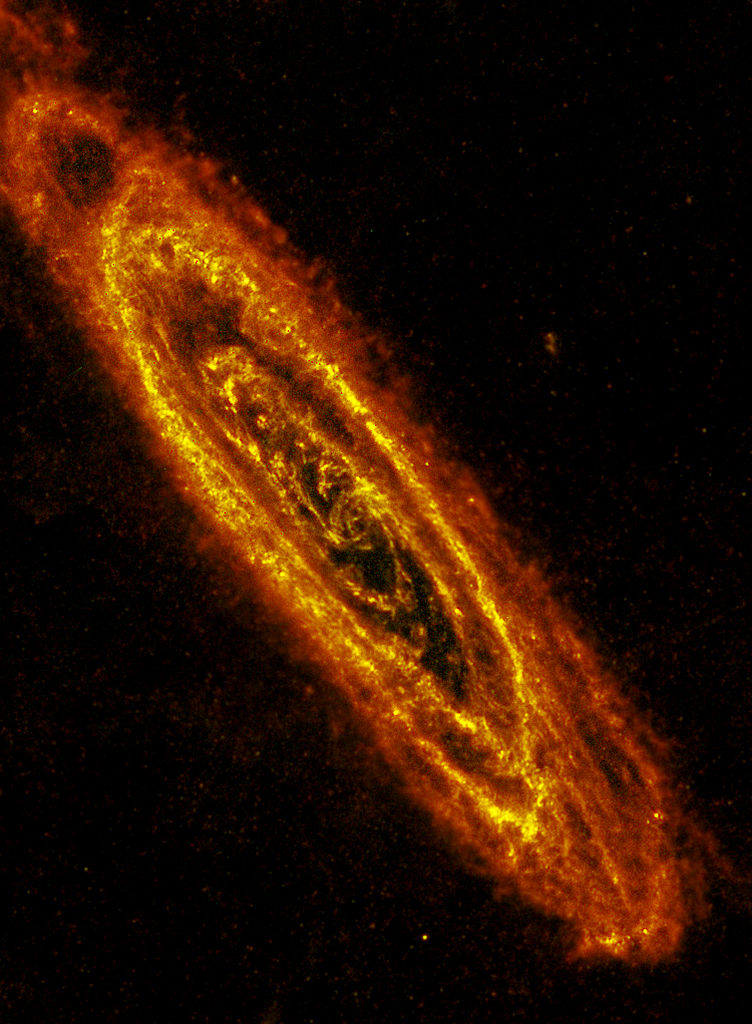
Herschel provides a detailed look at the cool clouds of star birth that line the galaxy’s five concentric rings. Massive young stars are heating blankets of dust that surround them, causing them to glow in the longer-wavelength infrared light, known as far-infrared, that Herschel sees. Image: ESA/Herschel/PACS/SPIRE/J. Fritz, U. Gent; X-ray: ESA/XMM Newton/EPIC/W. Pietsch, MPE
